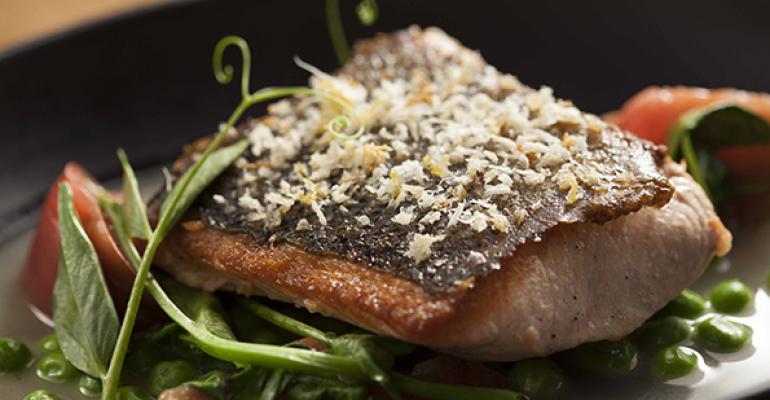Though farming practices are continuing to improve, many diners still view farm-raised fish as unnatural or bad. Across the country, talented chefs who are equally committed to great food and to seafood sustainability are trying to change diners’ minds with their menus.
“Farm raised is not second grade anymore,” said Damon Gordon, culinary director of Water Grill in Santa Monica, Calif. “It really has come leaps and bounds. It’s up there with wild.”
About 20 to 25 percent of the fin fish served at Water Grill is farm raised. Among the farmed fish Gordon is passionate about is Faroe Island salmon, which he menus during winter when wild-caught Pacific salmon is not in season. Gordon says the product, which is raised in free-flowing pens in the cold waters of the North Atlantic, meets the restaurant’s high standards for quality and sustainability, but also taste.
“We taste 20 different salmons every winter to taste the best. This one falls in line,” Gordon said. “It has a marbling and a fat content that you could mistake for wild.”
The secret to getting diners to order farmed fish is “truth in menu” coupled with a well-educated and well-trained staff, he said.
Steve Phelps, chef and owner of Indigenous in Sarasota, Fla., agrees that farm raised doesn’t mean lesser than wild.
“We need to kill the myth,” he said.
Phelps is trying to do just that by getting creative with some of the less desirable, but most abundant, farm-raised species, such as sturgeon. To make this locally raised, eel-like fish appealing to diners, Phelps recently marinated it in honey Dijon and balsamic vinegar, and then pan seared it, giving it a crispy crust, and a flavor similar to Asian barbecue.
“That turned out to be a homerun,” said Phelps. “We were able to turn some people onto that fish.”
On the other hand Matthew Beaudin, executive chef of the Monterey Bay Aquarium in Monterey, Calif., said he doesn’t feel the need to mask the taste of farm-raised fish. Instead, he argues that some of the farm-raised fish he is serving is better tasting than their wild counterparts.
“Aquaculture has the ability to take it in different directions in terms of taste and flavor,” he said. “We have found some of the most incredible tasting fish in farms and well-maintained fisheries.”
Beaudin is currently serving a smoked trout on grilled, oil and herb rubbed ciabatta with a fava bean and mascarpone spread. The dish is made with a trout that is sustainably and humanely raised in cold water from a California spring and fed an all-natural vegetarian diet of algae and plant-based products.
“I never experienced a flavor profile difference until I tasted this trout,” said Beaudin.
Also a hit with diners is Beaudin’s popcorn shrimp lettuce wraps with Sriracha aïoli, pickled cucumbers and seaweed. The shrimp is raised in Kauai, Hawaii, in recirculating saltwater pools. The seaweed is also farm raised.

“They are the sweetest shrimp I’ve ever tasted. Like candy,” said Beaudin. “Looking for green shrimp, I looked all over. The flavor profile of these took the cake.”
Available on the spring menu, both dishes were among the restaurant’s top-selling starters.
At RM Seafood in Las Vegas, Rick Moonen, arguably one of the most outspoken chefs on seafood sustainability, serves a variety of farm-raised finfish, including salmon, barramundi, artic char, sturgeon and sea bream.
But Moonen admits that sometimes it’s a struggle to satisfy his culinary passions and remain committed to sustainability.
“As a chef, cobia is so good. I love it, love it,” Moonen said. “But I can’t get it wild, it’s a single swimmer … and it’s not green [on the Seafood Watch list].”
As a compromise, Moonen doesn’t offer his beloved cobia as a permanent menu item, but only as an occasional special.
Another approach Moonen takes to menu diversity is serving lesser-known species. For example, he was recently introduced to the buffalo fish, a large “sucker” found in U.S. rivers and lakes that some say has become invasive. Moonen took some buffalo fish from a supplier and played around with it until he came up with a recipe for the barbecue buffalo fish tacos that he now offers as a special and which are popular with his guests.
“It’s a shift of mentality to be more diverse in our choices for dinner,” Moonen said. “I just keep presenting it.”
Correction: June 22, 2016 An earlier version of this story said that 70 percent of fin fish at Water Grill were farm raised, but the restaurant amended that number.





